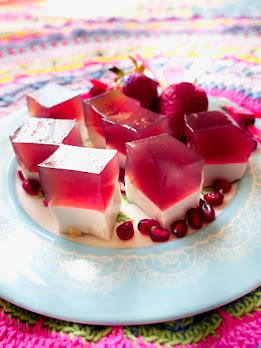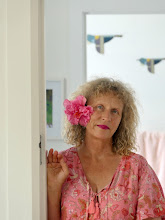Hello there dear friends & readers.
Here we are, once again...in the time of violets,
and daphne...
toasty wood fires, chicken stock in the slow cooker & pretty vintage blankets on our knees in the evening. The winter sun is low on the front veranda. Most days we put out fruit at the gate: lemons from Ted, grapefruit from the giant tree (huge as far as grapefruit trees go) across the road, walnuts from Ruth's gatherings & local oranges.Violets & seeds & even rose cuttings are continually being dispersed around the countryside at quite an alarming rate. So, as it happens, it was quite a challenge to create a little space so that I could go to Palmerston North with Rob, a week or two ago. He attended a Champions of Nursing training & I had a lovely time op-shopping.
What an utter delight it was to hear a "Hello, Catherine?" in the Red Cross shop, only to discover Gina, my friend (that I'd actually never met)...visiting from way up north & having the presence of mind to recognise me from this blog. We had such a lovely catch up over tea & I think we're both still marvelling at such an act of pure grace.
On our journey home Rob & I found a lovely old oak mirror in the Woodville Mart. Clever man discovered that we had very nice hooks in the back of one of our old wardrobes to make it perfectly useful. Our hallway has become a cloakroom
& even had a jolly good old clean. The ever patient driver screeched to a halt several times on the return journey home, so that I could pick some...rather sort after verbena bonariensis seeds. Good man, now the coat hook mirror is already half paid for!
I found this dear jug in The Salys in Dannevirke.
So cute.
I really do find violets enchanting.
I've decided I shall be a Collector of Violets.
Might be how I came across this little novel...the scent of them sent me on a violet mission; the memory of violets, the enchantment of these delicious little flowers,
coaxing out the stories stored in childhood...so many I've heard these passed few months: a mother who would gather bunches at the kitchen table & tie them up with string to sell to the florists, a grandmother who always gave a granddaughter a fragrant posy from the first of the violet blossoms each late winter. It's the simple warm memories that weave the most charm & remain indelibly pressed in to our hearts. One whiff and...you could find yourself transported to the flower markets of old London.
Primroses & polyanthus,
the promise of bluebells,hellebores
and sweetest primlettes.
All bring me back round to the scent,
the memoryof violets.
"A pretty and rare violet originating from Corfe Mullen in Dorset, so is sometimes known as the Dorset Violet.".
And so I began Hazel Gaynor's novel A Memory of Violets...
Life was terribly tough for the poor in London in the late 1800's & the little girls that faced life mired in poverty & orphaning, often survived on the filthy streets by selling violets or watercress to the wealthy passersby. They were known as The Flower Sellers.
The story unfolds with deceptive simplicity & reminded me of books of my childhood; yet slowly & surely the story is woven together with colourful threads of fragrant intrigue & purpose.
"1876. Among the filth and depravity of Covent Garden’s flower markets, orphaned Irish sisters Flora and Rosie Flynn sell posies of violets and watercress to survive. It is a pitiful existence, made bearable only by the presence of each other. When they become separated, the decision of a desperate woman sets their lives on very different paths.
1912. Twenty-one-year-old Tilly Harper leaves the peace and beauty of her native Lake District for London, to become assistant housemother at Mr. Shaw’s Home for Watercress and Flower Girls. For years, the home has cared for London’s orphaned and crippled flower girls, taking them off the streets. For Tilly, the appointment is a fresh start; a chance to leave her troubled past behind.
Soon after she arrives, Tilly discovers a notebook belonging to Flora Flynn. Hidden between the pages she finds dried flowers and a heartbreaking tale of loss and separation as Flora’s entries reveal how she never stopped looking for her sister. Tilly sets out to discover what happened to Rosie. But the search will not be easy. Full of twists and surprises, it leads the caring and determined young woman into unexpected places, including the depths of her own heart."
The story, I found fascinating on so many levels. So close to my own heart, the resonance of loss & struggle & abandonment...the sense that the world has set it's face against you & that you have no one to truly care for you & protect you.
The real Albert Shaw of the story, was a christian man named John Groom, who always had a sense that he was called to do more with his life than engrave silver. He eventually fulfilled that calling & set up homes for the Flower Sellers with charming names like Violet & Foxglove House, where they learnt to create artificial flowers as a way of life. Wonderfully, the girls work & plight was acknowledged in the most delightful way, told so well here:
"With a dozen occupants in each home, under the care of a Housemother, these women and young girls lived and worked together making artificial flowers in a nearby factory. It took them off the streets, gave them employment that wasn’t dependent on the seasons or the weather, and improved their quality of life immeasurably. The artificial flowers produced were mostly sold to the wealthy to decorate their homes, but the work of the ‘Flower Girls’ was eventually noticed by the Dowager Queen, Alexandra of Denmark (widow of King Edward VII).Queen Alexandra was to commemorate fifty years since she had first arrived in England from her native Denmark and rather than the usual processional drive through London, she wanted to use the occasion to raise funds for the city’s hospitals. Aware of the work of the girls at Groom’s ‘crippleage’ she commissioned them to make thousands of artificial pink roses for buttonholes which would be sold all over London.
The event on 26th June, 1912, was a huge success, supported by a thousand titled ladies who took to the streets to sell the roses. As The Times reported of the event, ‘the most noticeable sight was the enormous number of men who wore [a rose]. In the City and West End, at any rate, nearly every second men had at least one bloom and often had two or three in one buttonhole.‘ In total, over £30,000 was raised for charity (several million pounds in today’s equivalent). This was the very first ‘flag’ day of its kind, known as Queen Alexandra Rose Day, and the capital had never seen anything like it."
Photo & excerpt form here with many thanks.
So it seems...that beauty & kindness remain a saving grace.And an honour it is indeed, to have become a "Flower Seller" too; a woman immersed in fragrance & grace & beauty.
Thank you dear readers & friends for you patience with me & for your visit here.
Much love,
Catherine x0x0x






























































































